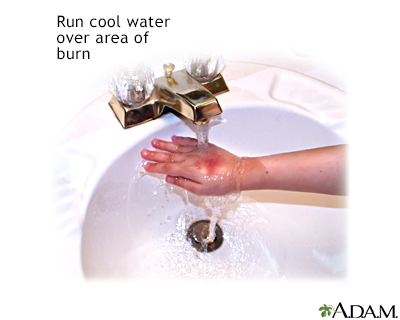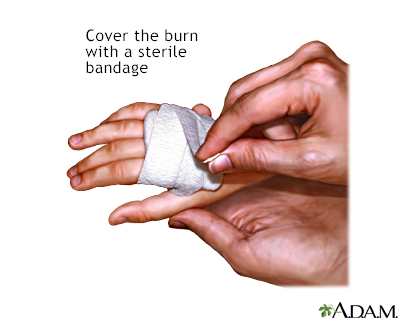Minor burns - aftercare
Partial thickness burns - aftercare; Minor burns - self-careYou can care for minor burns at home with simple first aid. There are different levels of burns.
Levels of burns
Burns commonly occur by direct or indirect contact with heat, electric current, radiation, or chemical agents. Burns can lead to cell death, which c...

First-degree burns are only on the top layer of the skin. The skin can:
- Turn red
- Swell
- Be painful
Second-degree or partial thickness burns go one layer deeper than first-degree burns. The skin will:
- Blister
- Turn red
- Usually swell
- Usually be painful
Treat a burn like a major burn (call or contact your health care provider) if it is:
- From a fire, an electrical wire or socket, or chemicals
Electrical wire or socket
An electrical injury is damage to the skin or internal organs when a person comes into direct contact with an electrical current.
 ImageRead Article Now Book Mark Article
ImageRead Article Now Book Mark Article - Larger than 2 inches (5 centimeters)
- On the hand, foot, face, groin, buttocks, hip, knee, ankle, shoulder, elbow, or wrist
First aid for Minor Burns
First, calm and reassure the person who is burned.
If clothing is not stuck to the burn, remove it. If the burn is caused by chemicals, take off all clothes that have the chemical on them.
Cool the burn:
- Use cool water, not ice. The extreme cold from ice can injure the tissue even more.
- If possible, particularly if the burn is caused by chemicals, hold the burned skin under cool running water for 10 to 15 minutes until it does not hurt as much. Use a sink, shower, or garden hose.
- If this is not possible, put a cool, clean wet cloth on the burn, or soak the burn in a cool water bath for 5 minutes.
Caring for Burns
After the burn is cooled, make sure it is a minor burn. If it is deeper, larger, or on the hand, foot, face, groin, buttocks, hip, knee, ankle, shoulder, elbow, or wrist, seek medical care right away.
If it is a minor burn:
- Clean the burn gently with soap and water.
- Do not break blisters. An opened blister can get infected.
- You may put a thin layer of ointment, such as petroleum jelly or aloe vera, on the burn. The ointment does not need to have antibiotics in it. Some antibiotic ointments can cause an allergic reaction. Do not use cream, lotion, oil, cortisone, butter, or egg white.
- If needed, protect the burn from rubbing and pressure with a sterile non-stick gauze (petrolatum or Adaptic-type) lightly taped or wrapped over it. Do not use a dressing that can shed fibers, because they can get caught in the burn. Change the dressing once a day.
- For pain, take an over-the-counter pain medicine. These include acetaminophen (such as Tylenol), ibuprofen (such as Advil or Motrin), naproxen (such as Aleve), and aspirin. Follow the directions on the bottle. Do not give aspirin to children under age 2 years, or anyone 18 or younger who has or is recovering from chickenpox or flu symptoms.
What to Expect
Minor burns can take up to 3 weeks to heal.
A burn can itch as it heals. Do not scratch it.
The deeper the burn, the more likely it is to scar. If the burn appears to be developing a scar, contact your provider for advice.
When to Call the Doctor
Burns are susceptible to tetanus. This means tetanus bacteria can enter your body through the burn. If your last tetanus shot was more than 5 years ago, contact your provider. You may need a booster shot.
Tetanus
Tetanus is an infection of the nervous system with a type of bacteria that is potentially deadly, called Clostridium tetani (C tetani).

Booster shot
All content below is taken in its entirety from the Centers for Disease Control and Prevention (CDC) Td vaccine information statement (VIS) -- www. c...

Contact your provider if you have signs of infection:
- Increased pain
- Redness
- Swelling
- Oozing or pus
- Fever
-
Swollen lymph nodes
Swollen lymph nodes
Lymph nodes are present throughout your body. They are an important part of your immune system. Lymph nodes help your body recognize and fight germ...
 ImageRead Article Now Book Mark Article
ImageRead Article Now Book Mark Article - Red streak from the burn
References
Mazzeo AS. Burn care procedures. In: Roberts JR, Custalow CB, Thomsen TW, eds. Roberts and Hedges' Clinical Procedures in Emergency Medicine and Acute Care. 7th ed. Philadelphia, PA: Elsevier; 2019:chap 38.
Palmieri TL. Burn injuries. In: Kliegman RM, St. Geme JW, Blum NJ, et al, eds. Nelson Textbook of Pediatrics. 22nd ed. Philadelphia, PA: Elsevier; 2025:chap 89.
Rybarczyk MM, Kivlehan SM. Thermal injuries. In: Walls RM, ed. Rosen's Emergency Medicine: Concepts and Clinical Practice. 10th ed. Philadelphia, PA: Elsevier; 2023:chap 54.
-
Minor burn treatment - run under cool water
Presentation
-
Burns - illustration
The depth of a burn determines its severity. First degree burns damage the outer layer of skin (epidermis) and cause pain, redness and swelling (erythema). Second degree burns damage the epidermis and the inner layer, the dermis, causing erythema and blistering. Damage from third degree burns extend into the hypodermis, causing destruction of the full thickness of skin with its nerve supply (numbness). Third degree burns leave scars and may cause loss of function and/or sensation.
Burns
illustration
-
Minor burn treatment - run under cool water
Presentation
-
Burns - illustration
The depth of a burn determines its severity. First degree burns damage the outer layer of skin (epidermis) and cause pain, redness and swelling (erythema). Second degree burns damage the epidermis and the inner layer, the dermis, causing erythema and blistering. Damage from third degree burns extend into the hypodermis, causing destruction of the full thickness of skin with its nerve supply (numbness). Third degree burns leave scars and may cause loss of function and/or sensation.
Burns
illustration
Review Date: 9/4/2024
Reviewed By: Jacob Berman, MD, MPH, Clinical Assistant Professor of Medicine, Division of General Internal Medicine, University of Washington School of Medicine, Seattle, WA. Also reviewed by David C. Dugdale, MD, Medical Director, Brenda Conaway, Editorial Director, and the A.D.A.M. Editorial team.






